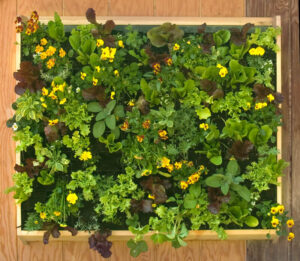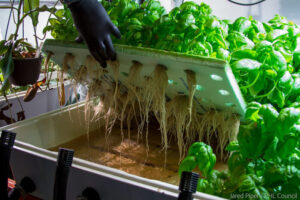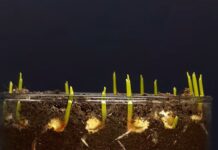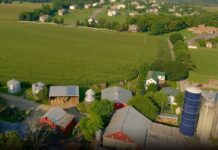
Introduction to vertical herb farming
Vertical Herb Farming cultivates herbal crops in stacked layers and vertically inclined surfaces. Herbs are pretty plants, flexible in the kitchen and easy to grow. A different variety of herbs can be grown from seed, starter plant and even cuttings. Using structures or columnar trees in vertical agriculture to build garden rooms or to identify secret spaces that are ready for exploration. Many vertical farms have greenhouse-like conditions, using natural daytime sunlight and primarily solar heating. Many vertical farms are indoors, using the controls of artificial lighting and heating and humidity. The method used to grow the plants in a vertical farm contains the following elements;
- Temperature control
- Humidity control
- Artificial lighting
- Control and monitoring of nutrients and fertilizer
The guide to vertical herb farming, cultivation practices
It is important to pursue vertical agriculture as a small to medium sized enterprise and to plan it. You need to make sure you can sell what you’re rising, and that the cost of production isn’t too high. So the first step to ensure this is to choose the right plants. The first challenge for vertical herbal farming is a climate management problem that must be solved by vertical farmers is to find out how much cooling, dehumidification, and heating is required to control the grow space temperature and humidity. The second biggest challenge is to find out how to deliver the air conditioning to make a standardized that atmosphere anywhere inside the vertical farm.Considerations of vertical farm space are not restricted to the flow of air conditioning through the racking system; they also require where to position HVAC equipment. The HVAC equipment includes air conditioners, dehumidifiers, ventilation fans, ductwork, chillers, boilers, pumps, and pipes, depending on the size. Whatever crops are grown in vertical farms, it is important to manage humidity control and air movement in a vertical farm for plant productivity, harvesting schedules, quality control, and ultimately, profitability.
Advantages of vertical herb farming
- The first and great advantage of vertical agriculture is that it produces extremely high yields per available land or field.
- Producing the food all year round without the risk of nature vagaries such as floods, heavy rains, uneven rains, hail and snowfall, drought, dry spells, extremely high temperatures, cold waves, pest and disease epidemics, etc.
- Vertical farming decreases the expense of moving food grain loads from rural to urban areas and eliminates the spoilage that occurs therein. Fossil fuel consumption is reduced to a greater degree when the farm produce is transported from village sites to cities.
- Vertical agriculture uses between 70 to 95 per cent less water than conventional farming. Vertical farming requires 90 percent less to no soil, and therefore no infestations of pests and diseases.
- Pesticide-free or organic foods are produced, because pesticides are not used.
- Consumers are getting fresh produce with all its original nutrient qualities due to the reduced food supply chain.
- High productivity per unit area, which in vertical farming means nearly 80 per cent more harvest per unit area. It would contribute to greening of urban areas and help to reduce increasing temperatures in cities and also air pollution.
Growing herbs in a sunny window
- If you fill up your vertical garden and still want more herbs, you can place them in a windowsill at any time.
- In a south-facing window, plants that enjoy a lot of sunshine and warmer temperature range would do well as they get the most hours of sun during the winter. Rosemary, thyme, basil, bay, and oregano are going to do fine here.
- Mint, parsley, chives, and chervil prefer cooler temperatures and do not need as much heat, so they do best in eastern or western windows that get 6 hours of sunshine a day.
- You should avoid putting more delicate herbs like basil in a window, since cold air from the glass will harm the leaves of the plant.
 The Best suitable herbs for vertical farming
The Best suitable herbs for vertical farming
Some popular herbs for vertical gardens are;
Coriander, parsley, basil, mint, marjoram, thyme , rosemary, nasturtium, salvia, lemongrass, chives, chili pepper, tarragon, oregano, Vietnamese mint, fennel, chervil, dill, lovage, watercress, wild rocket, stevia and ginger.
The kinds of herbs that you pick will depend on what you choose to use them for. Some plants are better to start from seeds, while others are hard to grow in that way and are bought from a garden center or nursery. Until you buy them, you must always search for rodents. Aphids, spider mites and scales are common on plants made from herbs.
Basil
Basil is one of the world’s most common herbs today, and is also a common option for small-scale urban growing. Plant growth in small growing containers will be stunted. This will be true even if you use water and nutrient solution flawlessly in the form of compost or other organic matter. Sweet basil is the common type of basil; other types contain purple basil (less sweet than common basil), lemon basil (lemon flavour), and thai basil (licorice flavor). Basil plant should grow best in a position that gets 6 to 8 hours of full sun a day, although it can also do well in part sun.Moist but well-drained soil needs to be. Basil plant works fantastically in containers or raised beds, because they allow better drainage.
Basil is another herb best used when it’s fresh, particularly in soups , sauces and fresh pesto. This likes a bit of humidity, so be sure you take this into consideration when choosing a location and design for a vertical garden. To avoid rot, basil plants should be watered at the plant’s base, not on the leaves. To maintain a fresh supply it must be started from seed and replanted every few weeks.
Chives and mint
Chives and mint are among the best vertical crops in cultivation. While grouped with herbs, both chives and mint have a fast turn and densely produce grass as well. Harvesting is easy and those herbs are some of the best crops to start with for new vertical farmers.
Chives are the ideal crop for upright cultivation. Chives are made of thin, hollow leaves, which grow up to 12 inches tall in clumps. They have a garlicy taste, and the best new when used. Harvesting leaves the plant as desired, and using it in savory dishes. Chives plants are considered a cool seasonal crop, meaning they grow best during the spring and fall. The colder summer temperatures cause them to fall asleep before the cool weather comes back again.
Start seeds indoors 6 to 8 weeks before the last spring freeze, for a head start in colder regions. Transplants require strong growth before they are placed in the garden. Chives grow best in full sun, with light shade tolerated. Soil needs to be humid, fertile, rich and well-drained. Incorporate 4 to 6 inches of well composted organic matter before planting in Chives.
Lavender
The crop grows very quickly upright. Lavender cultivation for profit may begin with lavender growing seeds or cuttings. This can cover sifted soil by a thin film. Yet growing off seeds takes a great deal of effort and expertise. If you are a beginner in the production of lavender you need to use cuttings. Agriculture of lavender flora is the most valuable commercial crop. The flowers in the garden so look beautiful. If your passion is gardening it has to be on top of the list of your plants because it is the easiest thing to grow.
Lemon Balm
It is a large leafy herb, which belongs to the mint family. Its leaves have a lemon fragrance with a hint of mint and it can grow to 24 to 36 inches but thrives on cutting back. It is a good plant for indoor growing, as it loses flavor when dried. The lemon balm is easy to create. The plants aren’t picky on where they grow and thrive in almost any soil but they need rich , well-drained soil. Plants can grow to full sun in partial shade but thrive best in full sun.
Parsley
So long as it gets some sun, Parsley is more than content to grow in a pot on a vertical plant. Grow usual, curled leaves, or Italian parsley, and use all three in Italian sauces , soups, and stews, or on noodles.
Rosemary
Rosemary herbs are super fragrant and ideal for vertical gardens. It has woody stems, and is very easy to grow. If you grow Rosemary from seed it can take some time, so we suggest buying this one for a starter plant. When your vertical plant is overtaken by rosemary, switch it to the garden and it will be a beautiful addition to your in-ground flower.
 Vertical herb farming considerations
Vertical herb farming considerations
Take these all elements into account when gardening vertically outdoors;
- Before planting, anchor your vertical farming structure in place to prevent disturbance of plant roots or stems. Place heavier or more demanding herbal plants with more robust structures.
- Tall herbal plants or structures cast shadows onto the vertical garden that will influence surrounding plant growth patterns.
- Within a vertical garden the herb plants grow differently. Herbal plants grown in a vertical garden may require more frequent watering and fertilization, because they are more exposed to light and wind.
Set up the irrigation system for vertical herb farming
To keep plants growing on a vertical surface, you would need an irrigation system that can offer moisture through the entire layer of the cloth. And you can make one with fittings that lock out from poly tubing. It is a tube with emitters over the top of the panel that drips water down.
You can buy a regular valve and irrigation dripper but you’re going to want a propagation timer that can be set for seconds instead of minutes. Depending on weather conditions and particular setup, you want a quick flow of water from 3 to 6 times a day for about 10 to 15 seconds. Add an emitter along the top irrigation tube every 2 to 3 inches and find the right balance between keeping the wall wet and not overwatering the plants. Using stainless steel hardware to fasten the frame to the wall (to prevent rusting). If you think you want to remove the frame or brackets that are stuck into the wall, hooks are perfect and the frame will work, too.
Environmental factors that affect plant growth
Large and well-studied environmental factors influencing plant growth include temperature, light intensity, light quality, humidity and concentration of CO2 in the soil, soil-current velocity, and nutrient and root zone conditions.
One of the great benefits of a managed environment and therefore of vertical farming is the possibility of tweaking and changing each environmental factor to optimize the production and desired outcomes for each crop. Comprehending all these main factors is crucial to optimizing the production of biomass in vertical farms. Control of each part, of course, comes at a cost, and each control level brings different results. Every grower wants to figure out whether a control system (usually automated) makes sense on a case-by – case basis, comparing the anticipated output and control benefit against the investments involved.This form of cost-benefit analysis is critical as growers decide if they should create a vertical system rather than a greenhouse that would depend on natural sunlight.
Vertical farming ideas for herbs
Vertical garden structure
Fences, arbors, trellises, obelisks, and other types of structures promote the growing of vertical plants. Hanging baskets can be considered vertical planting elements because they break the horizontal plane of gardening. For fast watering, mount the drip irrigation, or install a rope-and-pulley system to make it easier to reach hanging baskets for watering and tending your vertical garden.If you have an existing building such as a shed or workshop, install a trellis in front of one of the walls so that vertical farming plants have a foundation to support their stems but do not damage the wall at all. For good air circulation be sure to leave some space between the trellis and the wall.
Mounted Mason Jars – Glass mason jars mounted on an old barn or pallet wood can create a beautiful Vertical Herb garden
Recycled Bottles – This impressive and enticing vertical herb garden recycles herb homes with plastic bottles. The device is self-watering allowing the higher plants’ excess water to flow down to the lower plants.
Components of a vertical herb farming
The goal of vertical farming systems is not only to save energy, but also to find a more cost-effective way to produce food for the growing population and to reduce the cost and consequences of delivering that food to where people live. Vertical farming equipment produces “farms” where plants are put on shelves in trays, instead of being positioned horizontally over larger areas of land. Plants don’t rely on sunlight, rainwater, and pesticides in these structures but instead on LED lights and minerals. A commercial vertical farm relies on an artificial, thermally insulated, warehouse-like system in which airflow is held to a minimum and artificial light is used as the primary source of light for plant growth.

 The Best suitable herbs for vertical farming
The Best suitable herbs for vertical farming Vertical herb farming considerations
Vertical herb farming considerations




